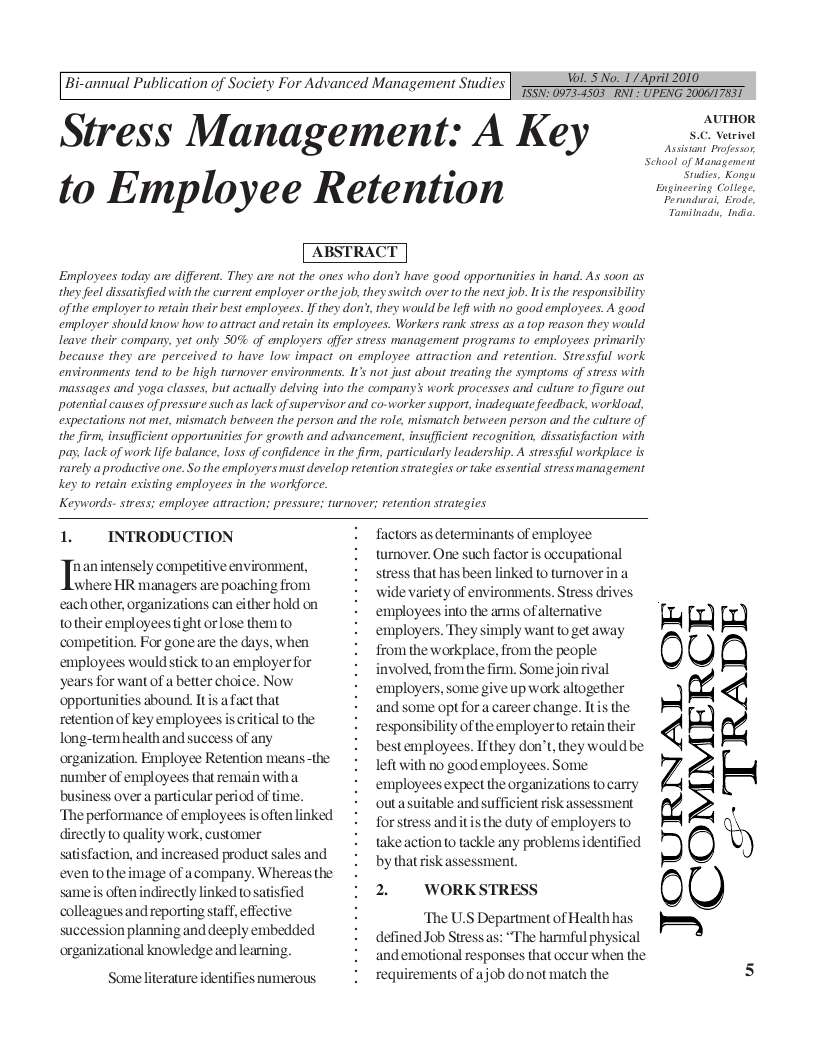Stress Management: A Key To Employee Retention
DOI:
https://doi.org/10.26703/jct.v5i1.367Keywords:
Stress, Employee Attraction, Pressure, Turnover, Retention StrategiesAbstract
Employees today are different. They are not the ones who don’t have good opportunities in hand. As soon as they feel dissatisfied with the current employer or the job, they switch over to the next job. It is the responsibility of the employer to retain their best employees. If they don’t, they would be left with no good employees. A good employer should know how to attract and retain its employees. Workers rank stress as a top reason they would leave their company, yet only 50% of employers offer stress management programs to employees primarily because they are perceived to have low impact on employee attraction and retention. Stressful work environments tend to be high turnover environments. It’s not just about treating the symptoms of stress with massages and yoga classes, but actually delving into the company’s work processes and culture to figure out potential causes of pressure such as lack of supervisor and co-worker support, inadequate feedback, workload, expectations not met, mismatch between the person and the role, mismatch between person and the culture of the firm, insufficient opportunities for growth and advancement, insufficient recognition, dissatisfaction with pay, lack of work life balance, loss of confidence in the firm, particularly leadership. A stressful workplace is rarely a productive one. So the employers must develop retention strategies or take essential stress management key to retain existing employees in the workforce.
Downloads
References
W. B. Schaufeli, and A. B. Bakker, “Job demands, job resources, and their relationship with burnout and engagement: A multi-sample study”, Journal of Organizational Behavior, 2004, pp.25, 293-315.
R. Eisenberger, P. Fasolo, and V. Davis-LaMastro,” Perceived organizational support and employee diligence, commitment, and innovation”, Journal of Applied Psychology, 1990, pp. 75(1), 51-59.
Z. D. Gellis, and J. C. Kim, “Predictors of depressive mood, occupational stress, and propensity to leave in older and younger mental health case managers”, Community Mental Health Journal, 2004, pp.40, 407-421.
R. T. Keller, “The role of performance and absenteeism in the prediction of turnover”, The Academy of Management Journal, 1984, pp. 27(1), 176-183.
D. N.Glaser, B. C.Tatum, D. M. Nebeker, R. C.Sorenson, and J. R. Aiello, “Workload and social support: Effects on performance and stress”, Human Performance, 1999. pp. 12, 155-176.
Abrams, Michael, “Raise Performance Bar for Manager to Retain Employee,” Patient Care Staffing Report, May 2001.
Michaels, E., Handfield-Jones, H., & Axelrod, B, “The war for talent”, Boston: MA: Harvard Business School Press, 2001.
V.Buenger, “Talent management systems: best practices in technology solutions for recruitment, retention and workforce planning”, Human Resource Management, 2006.

Downloads
Published
Issue
Section
License
Copyright (c) 2010 S. C. Vetrivel

This work is licensed under a Creative Commons Attribution 4.0 International License.










